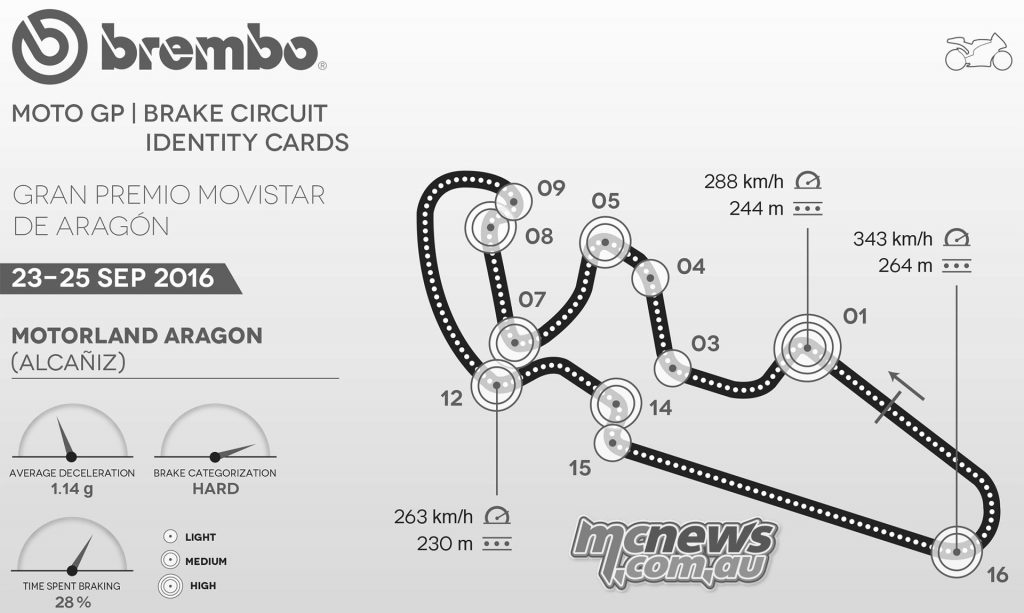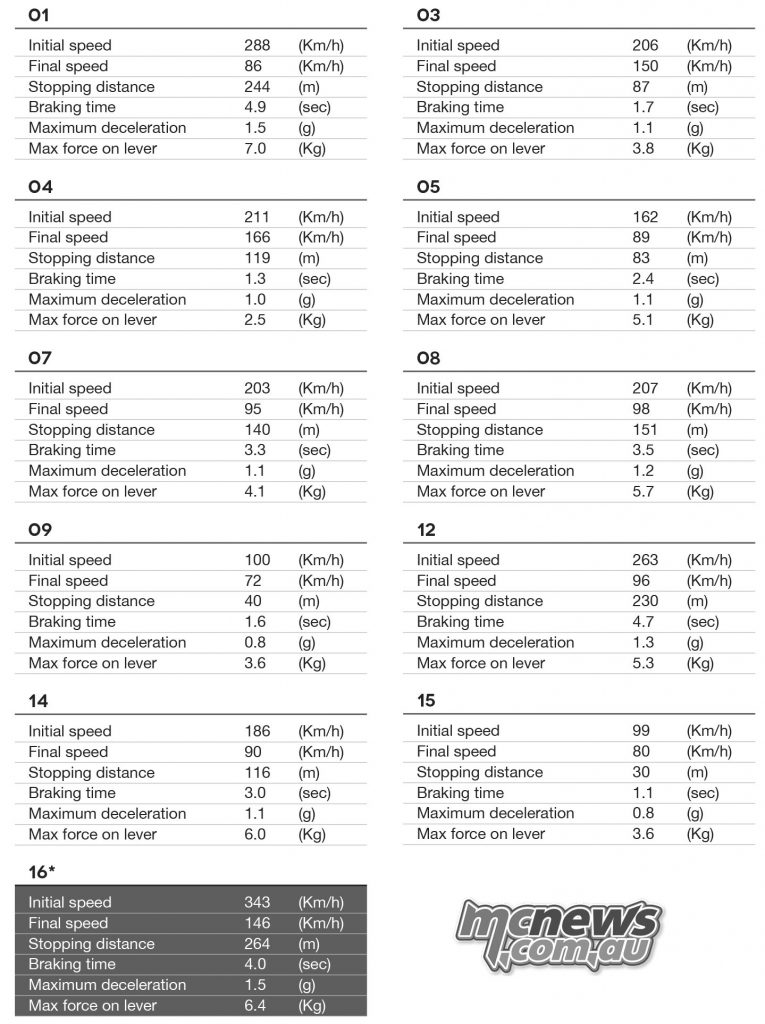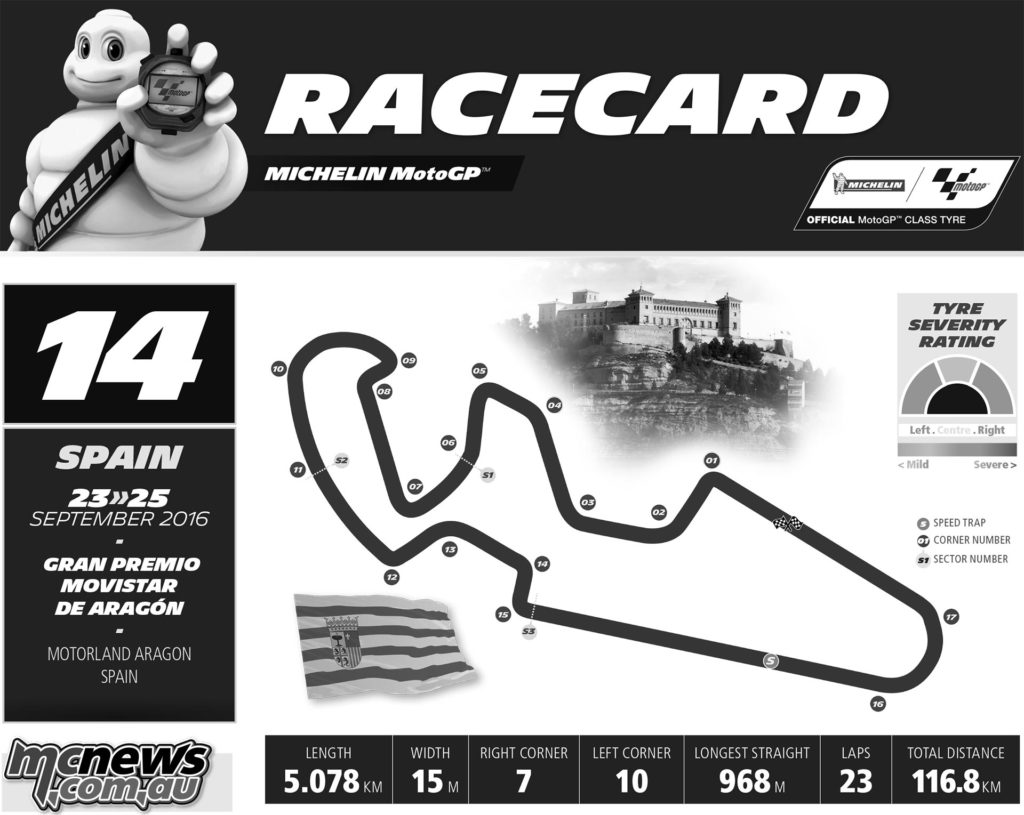Aragon MotoGP – The challenges for Michelin Tyres and Brembo Braking Data
An in-depth look at the premium class’ use of braking systems at MotorLand Aragón
The Motorland Aragon circuit is located near Alcañiz in Aragón, in north-eastern Spain. The track was designed by the German architect Hermann Tilke in collaboration with rider Pedro De La Rosa, and it was inaugurated on 6 September 2009. The MotoGP race has been held there since 2010 when it became the 4th World Championship GP on the Iberian peninsula.
The track used for motorcycle racing measures 5.077 km and is made up of two long straightaways that are separated by just a pair of curves. Curiously, while all of the fastest laps have been made by Spanish riders, the highest speed ever reached goes to Stefan Bradl: 341.6 km/h in 2013.
The circuit is considered rather technical and quite challenging for the brakes because it doesn’t allow the braking system to cool down well, especially on the first part of the track. That section contains an intense sequence of tight curves that stress the brakes.
According to Brembo technicians, who work with all of the MotoGP riders (Brembo is supplier to 100% of the premium class riders), MotorLand Aragón falls into the category of very challenging tracks for the brakes. On a scale of 1 to 5, it earned a 4 on the difficulty index, the same score given to 3 other tracks including the other Spanish circuit, Jerez.
The MotoGP bikes turn to their brakes 11 times per lap and a good part of those occur on the first half of the track. The second section is decidedly faster thanks to a 968-metre straightaway where the MotoGP bikes exceed 340 km/h. The brakes are used for more than 31 seconds per lap, which is 28% of the entire GP race. This many curves placed so close together translates into an average deceleration that is relatively low: 1.13 g.
Of the 11 braking sections at MotorLand Aragón, only one is considered highly challenging on the brakes, but 6 present mid-level difficulty and 4 are light.

The first curve is the hardest on the braking system because to take it, the bikes have to slow down by more than 200 km/h, going from 288 to 86 km/h in 244 metres. The riders apply 7 kg of force on the brake lever and are subjected to a deceleration of 1.5 g.
Braking at Curve 16, the second to the last, is also noteworthy: the bikes travel 264 metres and go from 343 to 146 km/h in 4 seconds net.
Curve 12 requires using the brakes for the longest amount of time: 4.7 seconds to reduce their speed from 263 to 96 km/h.
The only curve on the track named for a rider is the uphill turn 3, called the Carlos Checa, which requires limited use of the brakes: only 1.7 seconds with a 3.8 kg load on the lever and a 56 km/h drop in velocity that takes the bikes from 206 to 150 km/h.

Bikes with Brembo brakes have won all 6 of the GP races at Aragón: Honda won 3 times and Yamaha twice, and in 2010, Ducati took the victory at the inaugural race with Casey Stoner. In the last two editions, Jorge Lorenzo was victorious. Valentino Rossi has yet to stand on the top step of the podium here.
Aragon MotoGP on tyres
Michelin will be making history when it arrives at the Spanish circuit as this will be the first time the French tyre manufacturer has raced in MotoGP at this ultra-modern facility. With this in mind tyre selection and choice has been carefully considered due the unusual demands of the technical track. The anti-clockwise layout and medium abrasiveness of the circuit will give their own stresses to the tyres, machines and riders alike, along with the mixture of variable weather that can be encountered at the 5,077m circuit.
Motorland Aragón, also known as the Ciudad del Motor de Aragón, has 17 turns, and is challenging for technicians and exciting for spectators. To meet this challenge Michelin has brought a full range of Power Slick front tyres covering soft (white band), medium (no band) and hard (yellow band) compounds. The hard version will also feature an asymmetric design with a harder left-hand shoulder. These will be paired with a rear selection of medium (no band) and hard (yellow band) compounds, both of which will be asymmetric versions of the Power Slick with a harder left-hand side designed to work over the circuit’s layout, which features more left corners than right. With wet weather also likely at the Spanish circuit, Michelin will also have the Power Rain tyres available in soft (blue band) and medium (no band) for both the front and rear and the Power Inters (silver band), also for the front and rear, for use in mixed conditions.
Piero Taramasso – Michelin
“This will be the first time that Michelin has raced at Aragón, so this is a totally new challenge for us. We did test there last year with the MotoGP riders, so we do have a base knowledge of what to expect, but the tyres have changed so much since then it will be like starting all over again. From what we have been told and seen before, Aragón can be a very unpredictable place with cold or hot conditions. It has some very fast sweeping corners and a long straight, plus some hard braking zones, so we need to have a selection of tyres that can cope in all situations. The temperature in Spain at this time of the year can be quite pleasant, but due to Aragón’s position we can expect cooler mornings so we will need to have tyres that can heat up quickly in those conditions, but also work well as the temperature increases throughout the day. We know this is quite a technically demanding circuit, but we’re up for the challenge and looking forward to continuing from where we left off at Misano following a very successful race. For sure we hope it will be another exciting race!”
























